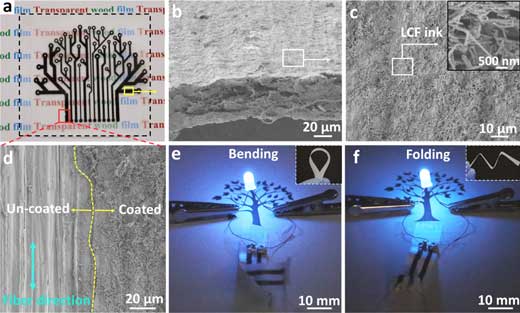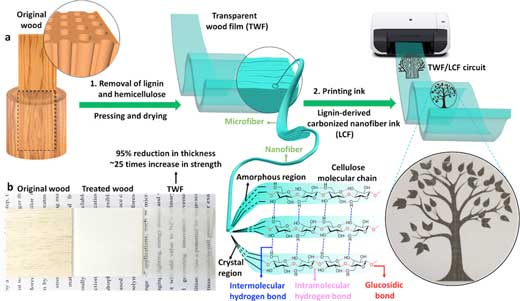
hotline:
17715390137
Tel/Wechat:
18101240246 (Technology)
0512-68565571
Email:mxenes@163.com (Sales Engineer)bkxc.bonnie@gmail.com
Scan the code to follow or search the official account on WeChat:
2D Materials Fronrier After paying attention,
click on the lower right corner to contact us,
Enter enterprise WeChat.
Professional Services Online

 (Nanowerk Spotlight) Wood has traditionally been used as wood or has been broken down into elementary fibrils before being restructured into various materials such as paper, cardboard and artificial wood products.
(Nanowerk Spotlight) Wood has traditionally been used as wood or has been broken down into elementary fibrils before being restructured into various materials such as paper, cardboard and artificial wood products.
Recently, nanocellulose from wood (a nanomaterial that breaks down wood fibers into nanoscale materials) has found other applications, such as strength enhancers for paper and biocomposites, packaging barriers, emulsifiers, oil separation, printing Substrates for electronics, filtration and biomedicine.
"Wood nanotechnology is not only related to the extraction and use of nanocellulose or lignin, but also to the customization and functionalization of the layered nanostructures of bulk wood for functional materials," said Fuqiliang Fu, a wood and fiber scientist at Scion, a government research organization in New Zealand. Tell Nanowerk. "In our latest research, we have adopted a top-down approach and performed a mild chemical treatment to preserve the complex structure and original orientation of cellulose fibers. By protecting the wood structure, a highly aligned, high-strength alignment can be obtained Cellulosic material. "
The latest report in ACS Nano ("Wood Flexible Electronics"), first written by Fu, details a method for producing wood-derived, completely biologically-based, environmentally friendly flexible electronic circuits.
In this work, the Scion team tailored wood nanostructures to create wood films with high transparency, flexibility and strong mechanical properties. According to researchers, this material has advantages over previously released two-dimensional cellulose-based materials for electronic or structural applications.

Processing of flexible and transparent wood film (TWF) for flexible electronics applications. (A) Explain the process. Removes lignin and half of hemicellulose from woody tissue. The treated wood is then pressed and dried under ambient conditions. The collapsed cell walls are held together by hydrogen bonds. The layered structure of TWF consists of cellulose microfiber bundles, nanofibrils and cellulose chains, including crystalline and amorphous regions. Bio-based amyloid / lignin-derived carbon fiber (LCF) ink is printed on a TWF substrate as a tree circuit. (B) Photographs of raw wood, treated wood and TWF. (Reprinted with permission from the American Chemical Society) (click image to enlarge)
This flexible circuit underscores the fact that wood can be used as a raw material and has the potential to replace petroleum-based materials to make high-value products.
The fact that this circuit and other nanocellulose-based circuits reside on the basis of the fact that the substrate and conductive elements are both obtained via wood nanotechnology.
Researchers electrospin lignin, which is a large by-product of wood processing. It has a high carbon content and then carbonizes it into conductive carbon fibers.
Taking advantage of the strong adhesion properties of amyloid fibers, the team then formulated a completely bio-based, renewable amyloid / lignin-derived carbon fiber conductive ink and printed it on a transparent wood film substrate To produce electronic circuits.
"Our work demonstrates the possibility of creating a synergy between a transparent, flexible wood film substrate and a conductive lignin-derived carbon fiber ink to produce a wood-derived circuit," Fu pointed out.
Transparent wood is a new area of research, driven primarily by Lars Berglund‘s laboratory (eg: "Wood windows? Transparent wooden materials developed by the Swedes for buildings and solar cells") and the Liangliang Hu laboratory at the University of Maryland ( For example: "Transparent wood can create new windows, cars and solar panels").
However, most transparent woods need to be impregnated with petroleum-based polymers (epoxy resin or PMMA) after delignification. This treatment makes the entire product non-biodegradable and mechanically fragile.
Dr. Fu received his Ph.D. from Professor Berglund‘s group, during which he pioneered the research on transparent wood. One day, he noticed that a thin delignified wood veneer sample had been stored in a beaker and dried under ambient conditions, and the sample became transparent and soft.
The discovery was shelved due to other commitments. However, it was always clear to his mind that this observation had great potential. Therefore, after serving as a Scion scientist, he established a laboratory facility to produce high-quality, highly transparent and flexible sturdy wood membranes. He quickly improved delignification and compression methods to obtain samples with high tensile strength and very smooth surfaces.
While manufacturing the first batch of fully wood-based flexible electronics, Fu and his team demonstrated prototype circuits and strain sensors for bending tests as a proof of concept. However, wood flexible electronics can be used in many other areas, such as wearables, smart packaging and sensors. It also has huge potential applications in designing energy storage devices such as flexible batteries and supercapacitors.

TWF flexible electronics demonstration. (A) Photograph of a flexible TWF electronic circuit. (B) SEM cross-sectional view of a wooden flexible electronic product. (C) SEM image of LCF ink dispersed on a flexible TWF surface. (D) SEM image of the TWF surface on the edge of the printed circuit board with ink-coated and uncoated areas. (E) and (f) Photographs of a flexible printed circuit board connected to a 9 V battery, which powers the LEDs (reproduced with permission from the American Chemical Society) via curved (e) electronic circuits and folded (f) electronic circuits ( Click on the picture to enlarge))
Due to its mechanical flexibility and complete biocompatibility, this type of electronic device is well-suited for integration into food packaging to track environmental conditions. Another application might be a disposable circuit. Increasingly, medical applications and event organizations use small electronic circuits for a certain period of time (for example, as short-term monitoring equipment or tickets).
"At present, the water sensitivity of substrates and the sensitivity of shear forces applied perpendicular to the fiber direction are our main concerns," Fu said. "However, we are now addressing the sensitivity of films to moisture. We are also exploring ways to produce environmentally friendly (bio-based / biodegradable) wood composites with high hydrophobicity."
He added that compared to graphene-based conductive inks, the electrical properties of wooden flexible electronics also need to be improved. The team is looking for post-processing options to improve electrical performance.
Now they are mainly working on developing new applications by improving the aforementioned weaknesses and adding new features to transparent wood film substrates, such as luminescence (due to the addition of quantum dots) and hydrophobicity.
In addition, by improving its adhesion, enhancing its mechanical strength, and increasing the electrical conductivity of the lignin-derived carbon ink itself, the rheology of the ink formulation has been adapted to various printers.
Fu concludes: "For example, we are already exploring the possibility of scaling up the process and have a continuous method of producing substrates using a roll-to-roll system." "Developing technologies for the production of transparent wood film substrates using multiple wood species It is of great interest. Scion is exploring the possibility of commercializing this bio-based ink. "
Source: nanowerk

| Reminder: Beijing Beike New Material Technology Co., Ltd. supplies products only for scientific research, not for humans |
| All rights reserved © 2019 beijing beike new material Technology Co., Ltd 京ICP备16054715-2号 |